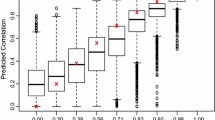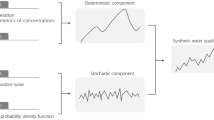Abstract
A new approach of model parameter estimation is used with simulated measurements to recover both biological and economic input parameters of a natural resource model. The data assimilation technique is the variational adjoint method (VAM) for parameter estimation. It efficiently combines time series of artificial data with a simple bioeconomic fisheries model to optimally estimate the model parameters. Using identical twin experiments, it is shown that the parameters of the model can be retrieved. The procedure provides an efficient way of calculating poorly known model parameters by fitting model results to simulated data. In separate experiments with exact and noisy data, we have demonstrated that the VAM can be an efficient method of analyzing bioeconomic data.
Similar content being viewed by others
References cited
Clark, Colin W. 1990. Mathematical bioeconomics. Wiley and Sons, New York.
Carrera, Jesus & Shlomo P. Neuman. 1986. Estimation of aquifer parameters under transient and steady state conditions: maximum likelihood method incorporating prior information. Water Resource Research 22(2):199–210.
Deacon, Robert T., Brookshire S. David, Fisher C. Anthony, Kneese V. Allen, Kolstad D. Charles, Scrooge David, Smith Kerry, Michael Ward & Wilen James. 1998. Research trends and opportunities in environmental and natural resource economics. Environmental Economics and Management 11(3–4): 382–397.
Gilbert, Jean C. & Claude Lemarechal. 1991. Some numerical experiments with variable-storage quasi-newton algorithms. Mathematical Programming 45:405–435.
Harmon, Robin & Peter Challenor. 1997. Markov chain Monte Carlo method for estimation and assimilation into models. Ecological Modeling 101:41–59.
Kalman, Rudolf E. 1960. A new approach to linear filter and prediction problem. Journal of Basic Engineering 82:35–45.
Kirkpatrick, Scott, Gellat Daniel & Mario Vecchi. 1983. Optimization by simulated annealing. Science 220:671–680.
Lawson, Linda M., Spitz, H Yvette, Hofmann, E. Eileen & Robert B. Long 1995. A data assimilation technique applied to predator-prey model. Bulletin of Mathematical Biology 57:593–617.
Matear, Richard J. 1995. Parameter optimization and analysis of ecosystem models using simulated annealing: a case study at station papa. Journal of Marine Research 53:571–607.
Navon, Michael I. 1997. Practical and theoretical aspects of adjoint parameter estimation and identifiability in meteorology and oceanography. Dynamics of Atmospheres and Oceans 27:55–79.
Schaefer, Milner B. 1964. Some aspects of the dynamics of populations important to the management of commercial marine fisheries. Bulletin of the Inter-American Tropical Tuna Commission 1:25–56.
Smedstad, M. Ole & James J. O'Brien. 1991. Variational data assimilation and parameter estimation in an equatorial pacific ocean model. Progress in Oceanography 26(10):179–241.
Spitz, H. Yvette, Moisan, R. John, Abbott R. Mark & Jim G. Richman. 1998. Data assimilation and a pelagic ecosystem model: parameterization using time series of observations. Journal of Marine Systems 16:51–58.
Author information
Authors and Affiliations
Rights and permissions
About this article
Cite this article
Ussif, Aa.M., Sandal, L.K. & Steinshamn, S.I. Estimation of Biological and Economic Parameters of a Bioeconomic Fisheries Model Using Dynamical Data Assimilation. Journal of Bioeconomics 4, 39–48 (2002). https://doi.org/10.1023/A:1020603902192
Issue Date:
DOI: https://doi.org/10.1023/A:1020603902192




